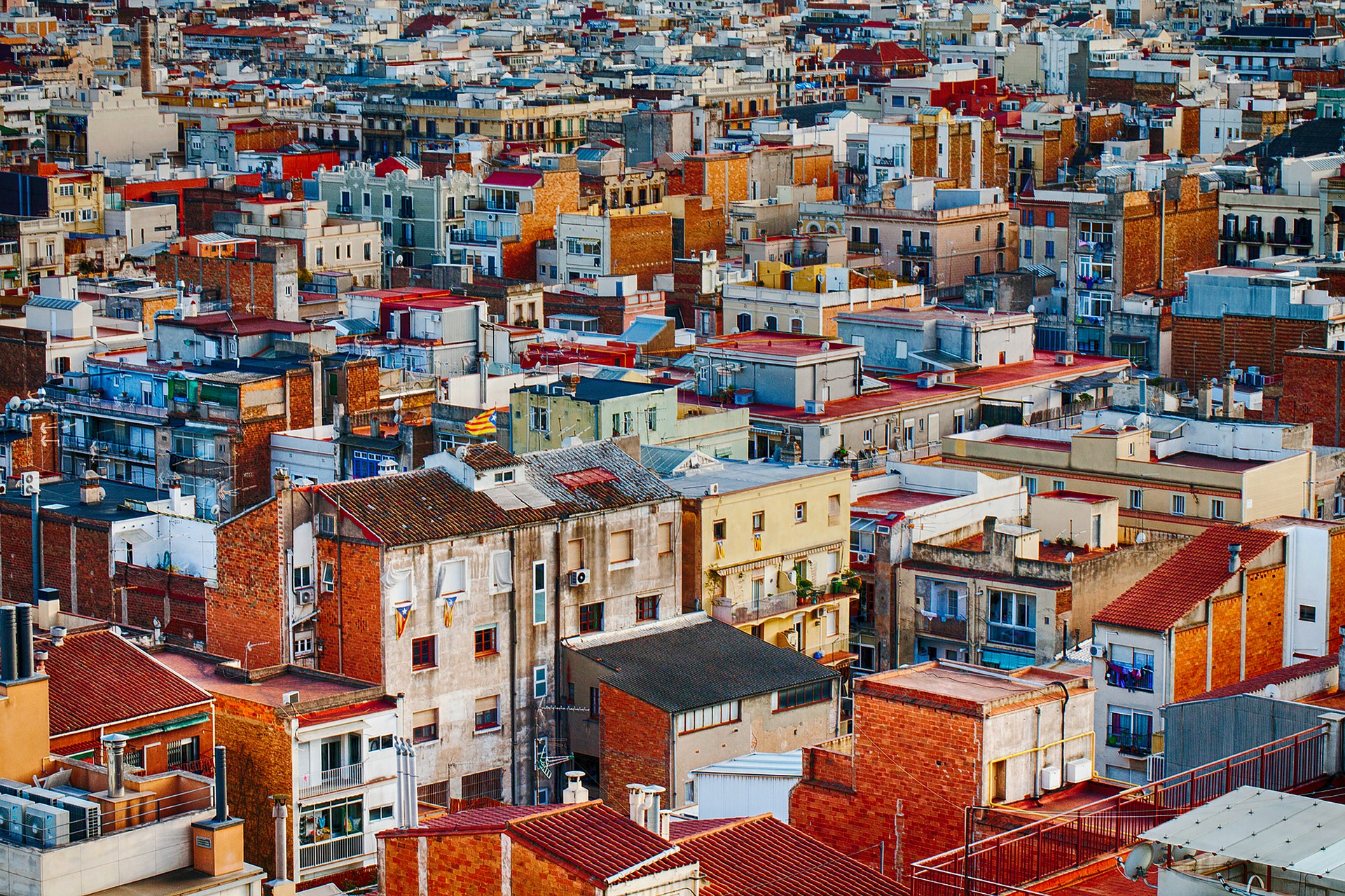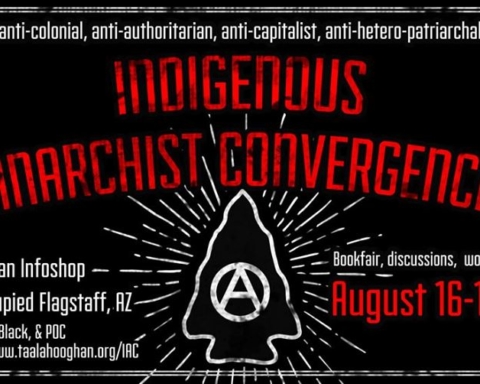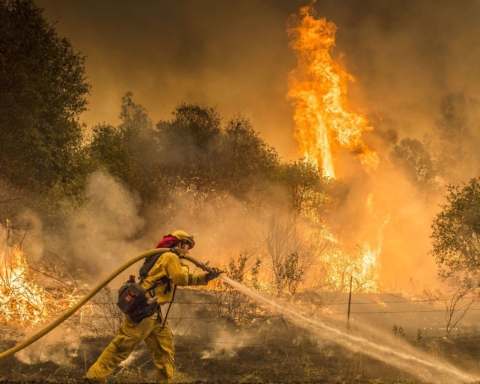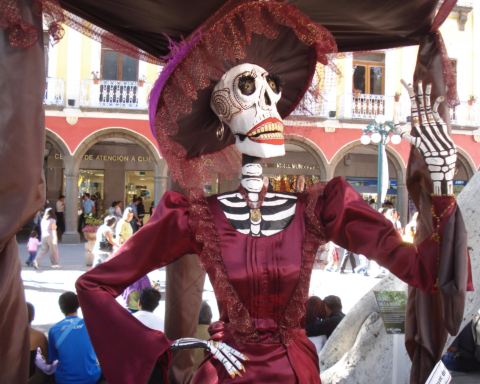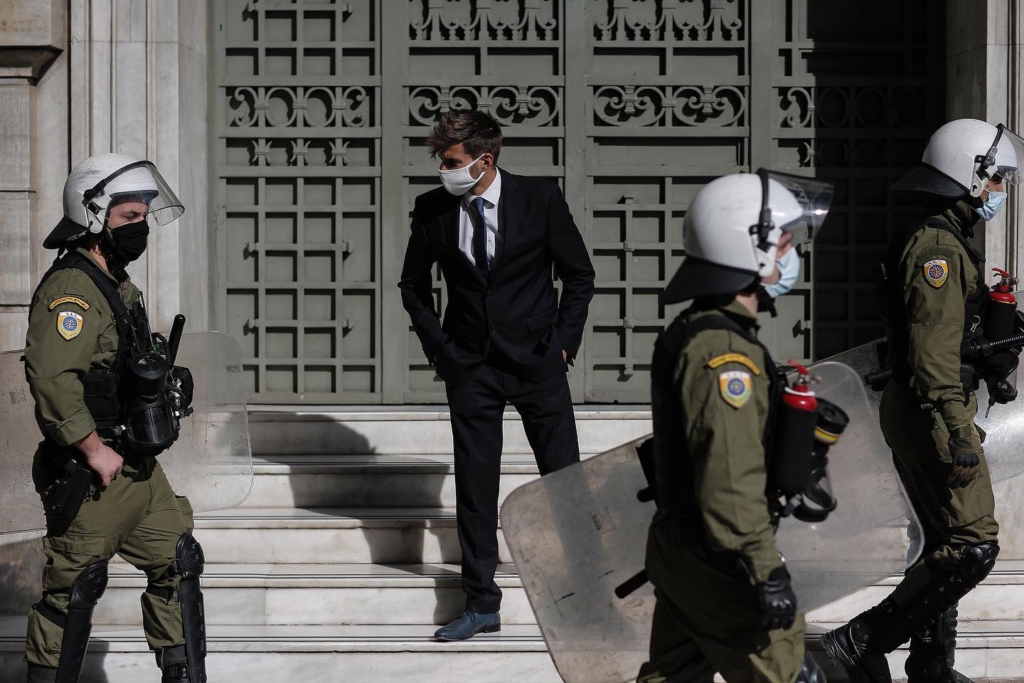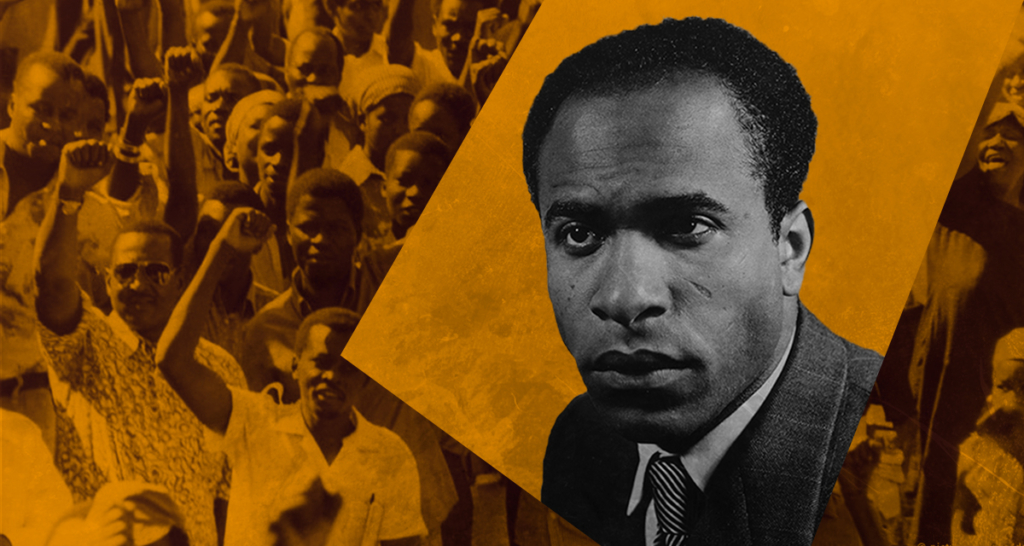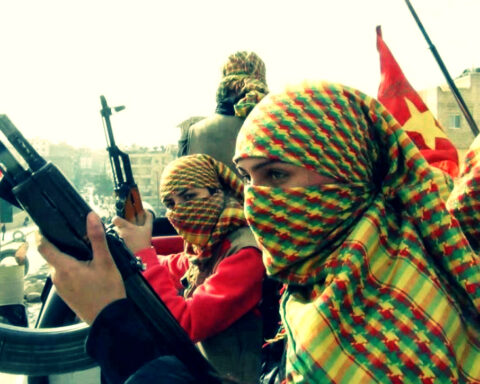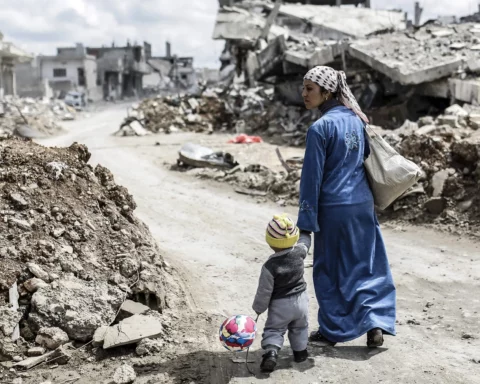A housing movement on the fringes of Mexico City offers an example of the fruits of breaking with the clientelism that has long dominated Mexican politics to build autonomous alternatives in its communities.
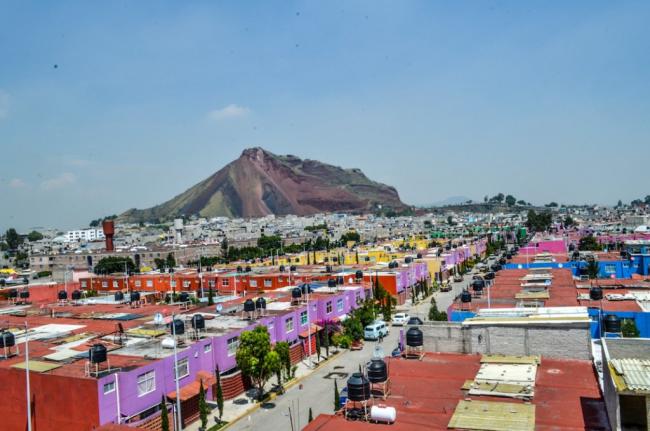
The community of Acapatzingo (Photo by José Luis Santillán/Creative Commons)
Walking through La Polvorilla on the southeastern fringes of Mexico City, a rare sense of ordered calm fills the neighborhood. The eye lingers on posters announcing workshops and classes for local residents and the rust-colored peaks of Montaña de Alvarado and Volcán Xaltepec, jutting up a short distance away. The community’s open spaces, clean streets, abundant greenery, and uniformly built, well-maintained two-story houses stands in sharp contrast to the surrounding area of the Iztapalapa borough, which is the most crime-afflicted and one of the most impoverished of Mexico City’s 16 boroughs. La Polvorilla is a kind of oasis wedged within the chaos and disorder that defines much of the built environment in Mexico City’s neglected periphery.
The difference between the two is the result of the popular struggle for housing, democracy, and a better life for Mexico City’s urban poor. La Polvorilla, officially known as La Comunidad Habitaciónal Acapatzingo, is an autonomous community with more than 4,000 residents. Hailed by Raúl Zibechi as “one of the most important autonomous experiences in Latin America,” La Polvorilla was founded in 1994 when the socialist Frente Popular de Francisco Villa (FPFV) organized a land invasion and squat. Previously a quarry and mining area, the land had become a dumpsite for debris after the devastating 1985 earthquake. In 1998, the movement leading the occupation bought the land with a combination of funds the organization raised and credit from Mexico City’s housing institute, Instituto de Vivienda del Distrito Federal (INVI).
Two years later, in 2000, residents began building permanent housing, transforming their make-shift squat—constructed out of rubber, wood, sheet metal, and cardboard—into buildings made of sturdier materials. The neighborhood also self-constructed a clinic, a library, a pirate radio station, soccer fields and basketball courts, greenhouses, and other urban infrastructure. Once a literal dump, La Polvorilla is now an active, safe, and militant neighborhood, committed to building a socialist society grounded in collectivist practices of mutual aid and autonomy from the state, government institutions, and political parties. [See also: Building Homes, Building Lives in Mexico City in NACLA’s Winter 2019 print issue].
Today, La Polvorilla is affiliated with the Organización Popular Francisco Villa de Izquierda Independiente (OPFVII), an offshoot of the FPFV. Apart from La Polvorilla, the OPFVII has self-constructed nine other communities in which a total of 3,000 people live, all in the southeast of Mexico City. The OPFVII is distinct from most urban popular social movement organizations in Mexico City in its absolute commitment to organizational autonomy. It is both a strategic and ideological answer to the key question that Mexican social movements have faced since the 1980s: To what extent, if any, should a movement organization collaborate with the state?
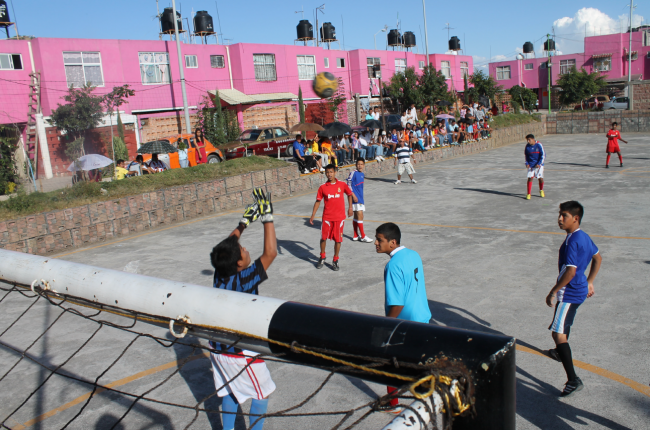
A soccer game in the community (Photo courtesy of OPFVII)
Roots of the Urban Popular Movement
The debate over social movement cooperation with the state was and is salient because cooptation was the longstanding preferred method of the Partido Revolucionario Institucional (PRI) to demobilize social movements that threatened its dominance. PRI presidents governed Mexico from 1929 to 2000 and created organizations to represent different sectors: workers, peasants, Indigenous peoples, the urban poor, and others. The government also worked to incorporate those organizing outside official party or state channels through clientelism. In the urban periphery, this would look like a PRI representative offering a community help in acquiring basic urban infrastructure in exchange for political support—in other words, materials to build a road could be provided, if the community delivered votes, attended rallies, and canvassed for the party. In addition to clientelism, outright violence was a key way the PRI demobilized social movements, most famously illustrated by the 1968 Tlatelolco massacre.
This system began unraveling for the PRI in the 1980s, most of all in the urban peripheries of Mexico’s rapidly growing cities. Already the sector of the population least incorporated into the PRI’s clientelistic networks, the urban poor completely abandoned the party. State neglect of rural areas combined with a development plan that heavily centralized economic activity and opportunity in Mexico City led to roughly 500 migrants arriving daily to the capital from the countryside between the mid-1970s and the early 1980s. Many of these migrants settled on the margins of the city, especially in the southeastern boroughs of Iztapalapa, Ixtapaluca, and Tláhuac, where the OPFVII organizes today.
The rural to urban migration boom alone would have posed a huge challenge to the PRI’s ability to expand urban services and infrastructure, but it also coincided with a full-blown economic crisis. Reeling from a near-default in 1982, double-digit unemployment, and yearly increases in the price of dietary staples of around 300 percent, the PRI implemented severe austerity while prioritizing foreign debt payments over the basic needs of its citizens. According to statistics compiled by Diane Davis in her book Urban Leviathan, between 1984 and 1985, the government reduced spending by 12 percent on transport, 25 percent on potable water, 18 percent on health services, 26 percent on garbage collection, and 56 percent on land regularization, which would mark the beginning of Mexico’s transition to neoliberalism. Spending reductions diminished the state’s capacity to create and sustain the clientelistic networks that defined the PRI’s corporatist mode of governing. On top of that, when the 1985 earthquake destroyed thousands of buildings and major infrastructure in Mexico City, the PRI failed to respond in any meaningful way, laying bare its corruption and incompetence. Support for the party in Mexico City completely collapsed.
In this context, major mobilizations of the urban poor were demanding housing, infrastructure, and a democratization of urban governance. In 1988, the center-left Partido de la Revolución Democrática (PRD) party, riding the energy and many of the organizational networks behind the mobilizations, fell just short of the presidency in an election the PRI has since admitted was fraudulent. The PRD would subsequently capture power in Mexico City. The same racket returned: The PRD collected support from the urban poor in exchange for often-empty promises. Now, however, organizations that had previously been on the forefront of popular uprisings served as intermediaries.
The decision of many urban popular organizations previously unaffiliated with political parties to engage in electoral politics and subordinate themselves to the PRD was a major factor in the movement’s demobilization. The departure of reform and electorally-minded movement leaders for state bureaucracy and elected positions left much of the movement without leadership. But it also served to consolidate the more radical currents of the movement. These organizations used direct action tactics like land invasions, articulated their goals in explicitly socialist vocabulary, and developed a comprehensive critique of clientelism, state corruption, and the corporatist mechanisms of political representation that disenfranchised the urban poor. They also demanded urban services and housing, as well as autonomy from the state and political parties. This is the tradition from which the OPFVII and La Polvorilla emerged.
Autonomy and Self-Governance
Organizations that emphasize autonomy in a project of developing unused land for the urban poor share several traits, which are referred to as autogestión across the Spanish-speaking world: direct and popular participation in the planning, construction, and administration of the community; a robust commitment to internal bottom-up democracy; and the rejection of government technical experts in favor of experts who are members of the organization or likeminded allies. These organizations also use land invasion and squatting—usually on state-owned or ejido land—as a means to initially acquire territory, which they then militantly defend from state eviction efforts. Marches and sit-ins will often accompany the negotiating process with city government to both avoid eviction and eventually legally acquire the land.
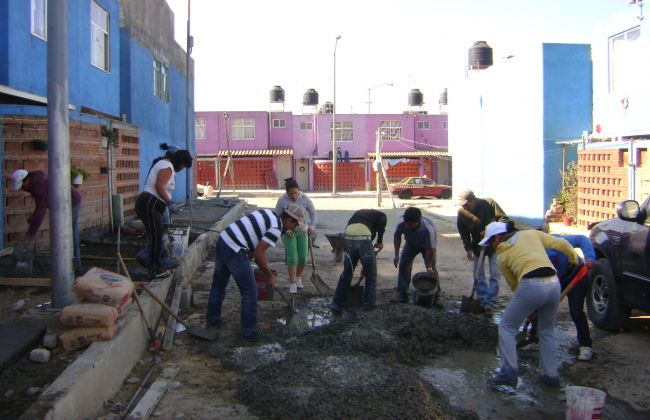
Community members participate in construction efforts (Photo courtesy of OPFVII)
For the OPFVII, autonomy encompasses more than self-constructing housing and infrastructure. If this were the case, it would simply be a kind of real estate development cooperative for the urban poor. “Housing is the principle demand for all the compañeros that join the organization. It is the pretext for organizing,” said Rosario Hernández Aldaco, a member of the OPFVII’s political commission. The organization politicizes the lack of housing and infrastructure for the urban poor as the initial step in project to remake social relations based on horizontality, cooperation, collective work, and solidarity. “Not just a project for housing, but a project for life,” is a common refrain among the organization’s leadership. For the OPFVII, building a democratic and collectivist movement culture is as important as building housing.
Housing and community construction also forms an important foundation in creating this movement culture. When regular people build a neighborhood together—relying on each other rather than on a political party, NGO, or corrupt government—they witness and experience their capacity to meet their individual and communal needs through working collectively. “The construction process creates a consciousness that we have to come together and organize to create a better life,” said Hernández Aldaco.
However, the primary way that OPFVII builds movement culture is through the organization’s structure, which ties individual members to one another in different groupings and at different levels of the organization. The basic units of the organization are the brigades, which are each comprised of 25 families. The brigades send members to each of the commissions responsible for different work in the communities: communication, education and culture, health, maintenance, finance and administration, and security. Each housing settlement also has a general assembly, which takes place monthly in La Polvorilla, and weekly in some of the other communities. At these assemblies, the elected representatives of each commission report back on the work being carried out and its plans for future work. Finally, the entire organization participates in a Congress every two years. At the most recent Congress last May, 692 delegates attended, signaling that the OPFVII has a large tier of mid-level leadership. The presence of a sizeable group of leaders is extremely important to the OPFVII, which views it as a sign of the membership’s ideological development as well as an important contribution to the organization’s ability to continue growing into the future.
From initial recruitment phases, which are aimed at friends and family members of existing members, the organization tells potential residents that joining the community marks a life-long commitment to building a democratic and socialist society.A common problem for urban popular movements that build housing is keeping members mobilized after construction is complete. Many urban autonomy projects exhaust themselves in the process of introducing urban service and regularizing their land tenure. OPFVII combats the tendency towards stasis in a few ways, but most simply it manages to do so because the organization’s raison d’être encompasses far more than housing. The membership is keenly aware of this. From initial recruitment phases, which are aimed at friends and family members of existing members, the organization tells potential residents that joining the community marks a life-long commitment to building a democratic and socialist society. A consistent stream of new people joining the organization keeps it fresh, while each individual community’s leeway to make its own decisions about how to operate decentralizes power. The overall effect is a militant organization of the urban poor rapidly growing in a moment when nearly all other popular organizations have become ossified, fragmented, and part of the bureaucracy of the PRD, PRI, or MORENA, the center-left party of President Andrés Manuel López Obrador.
The OPFVII has nearly doubled in size in the last 10 years while claiming nine new territories. While the organization has no plans of slowing down, conditions for its organizing have changed. Claudia Sheinbaum, Mexico City’s mayor from the MORENA party that won power in 2018, recently disqualified social organizations from receiving funds from the city’s housing agency, INVI. After protests from urban popular organizations, like OPFVII, that access these funds, Sheinbaum announced plans to once again revise INVI’s rules. Sheinbaum then removed the director of INVI, Pedro Sosa Álvarez, and replaced him with Rodrigo Chávez Contreras, most recently a leader of the MORENA-aligned social housing development organization Asamblea de Barrios. Contreras’s appointment signals the continuation of an 80-year-old pattern in Mexican politics: Administrators award public resources to popular organizations in exchange for electoral support.
Alternative in Practice
Refusing to play the game has made obtaining credit from INVI a challenge for the OPFVII since its inception. “Accessing the credit and resources provided to build housing has always been a problem for us,” said Hernández Aldaco. The over three years of contradictory decisions, information, and delays the OPFVII endured in obtaining credit from INVI to build La Polvorilla is a stark example. Meanwhile, other social housing organizations with “neither a blueprint nor land, but a good relationship with an official” were awarded credit, explained Enrique Reinoso, an OPFVII leader at La Polvorilla in the 1990s. In this regard, the OPFVII’s leadership expects their relationship with authorities to be the same, if not worse, with MORENA’s government.
But the OPFVII is not discouraged: two new communities are under construction, one of which is almost finished and the other just beginning. The nearly finished community, named Zapotlán, will have 80 housing units after two years of construction—a far quicker turn around time than a real estate corporation or the state would need for the project. The organization also feels it achieved the greatest autonomy from the state yet with this specific construction process by managing all aspects of administration and labor for the project. Another step the OPFVII is taking to increase autonomy from the state and its institutions is developing community-centered justice systems so that disputes can be handled according to the organization’s principles and ideology. Police only are admitted into OPFVII territories if they are unarmed and with with prior permission from the given community.
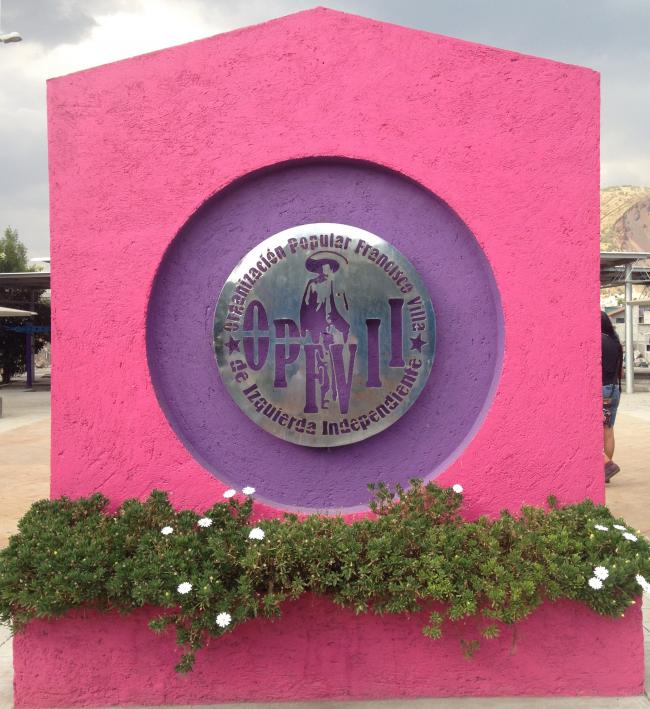
The crest of the OPFVII movement (Photo by Evan Neuhausen)
OPFVII’s total rejection of collaboration with political parties and near-total rejection of the state have guided it over the last 25 years and will continue to be one of its defining characteristics as it autonomously and democratically develops unused land in Mexico City. It offers a refreshing alternative to the clientelism that has defined Mexico’s politics—and especially its urban politics—for 80 years.
The OPFVII poses a question of if and how autonomous projects may excuse the neoliberal retrenchment of a state that answers to foreign capital above the basic needs of its urban poor. From a certain cynical point of view, autonomous housing projects “justify” the government’s lack of investment. This viewpoint is far too narrow a conception of what autonomous movements do.
What becomes clear from the OPFVII experience is that for the people involved, organizing is a struggle for freedom that, in Reinoso’s words, shows that “there are other ways to live and build” communities. These alternative possibilities, in which people look to each other rather than the state or political parties as caregivers, will be part of any movement that succeeds in transforming Mexico City into a more just and equitable city. The OPFVII will not be stopping anytime soon. As Hernández Aldaco said, “The project for life lasts a lifetime.”
Written by Evan Neuhausen – a researcher, translator, and archivist. He lives in New York.
Source: https://nacla.org/news/2019/12/30/Polvorilla-mexico-city-housing
